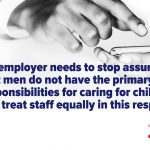I was minding my own business early yesterday morning, my head full of ideas to entertain my kids on the first day of the half-term break from school. I then spotted a news story on the BBC website. Had I been eating cornflakes at the time I’d have spat them out over my computer monitor in surprise. The news story, you see, was about the Government going on a charm offensive to encourage more men to take shared parental leave.

I maybe shouldn’t have been so surprised. The Government committed itself to reviewing shared parental leave in 2018 some time ago. With Brexit hitting the buffers once again and Universal Credit making the headlines for all the wrong reasons, I simply thought the Government had quietly dropped this pledge.
Not only has the Depart for Business reviewed it, but the official line is that men should ‘share the joy’ with their partner and take up their right to the leave. The hashtag #sharetheleave is even doing the rounds on social media.
This is far more than I expected at this point in time, although it does beg the question as to why men are having to be encouraged to exercise their right to take shared parental leave. Keep that question in mind. I’ll come back to it.
Let me take my foot off the accelerator for a moment. It may be that you aren’t entirely familiar with shared parental leave. The system is complex and many people, including many employers, still have little knowledge of the policy.
If you want the full detail, read this post from my blog’s archive. In brief, however, the old maternity and paternity leave systems were done away with in 2015. In its place, mums and dads receive 50 weeks of leave following the birth of a child. This can be shared between them in any way they see fit. As an example, they could both take six months off work at the same time. Alternatively, dad could take two months off work and mum 10 months and so on and so forth. There are limits to the pay you receive, rules to follow and exceptions, but the gory detail is in the blog post I have highlighted.
So why exactly are Government Ministers hitting the media and telling dads to take time off work to hold the babies? The Government thinks just 2% of eligible men are taking shared parental leave, although I’ve heard a slightly rosier story from other sources suggesting the figure is closer to 8%.
There are many, many reasons for this but I’ll highlight two:
1) Entrenched gender roles in British workplaces and
2) The way shared parental leave was introduced.
To this day, the accepted wisdom is that mum will take an extended period of leave from work following the birth of a child. Dad may take a couple of weeks, maybe a month, but that’s his lot.
Some men, I’d like to think a relatively small number, don’t consider it their job to be around in the early days of their offspring’s life. Many other men are desperately worried as to how employers will react if they take months off work to be with their newborn. After years of fighting for paid maternity leave, some women are understandably reluctant to share what they consider to be their leave.
Added in to this mix, some employers offer women enhanced maternity pay but don’t offer any such payments to men. Shared parental leave is a great idea, but what we introduced in the UK wasn’t really shared parental leave. What we actually introduced was a system of transferable maternity leave. Although this may not have been the intnetion, mum is still very muich in control of the leave and she can effectively decide whether dad gets any leave and employers frequently make it difficult for dads to take the time off.
I said I’d come back to what changes need to be made to the shared parental leave system. There are many issues that could and should be addressed but I’d argue the biggest barrier is the lack of ring-fenced leave reserved solely for dad’s use. Around three months of that shared parental leave needs to be ring-fenced solely for a child’s father. If he doesn’t take his ring-fenced leave, he should lose it.
As a rule, I dislike positive discrimination. Unfortunately, gender roles in the workplace are so entrenched I think this is the only option. It would force employers to accept that men would take shared parental leave and dads would no longer have to worry about what their employer might think about spending time with their newborn. Those dads who didn’t think it was their job to be around their newborn would need to buck-up their ideas (in fact they’d probably find it an incredibly rewarding experience).
Norway, Sweden and Iceland introduced shared parental leave long before the UK. Each one of these nations found it necessary to introduce periods of ring-fenced leave for dad to make the system work properly. In a shrewd and sensible step to ensure the system was fair, some leave was also ring-fenced solely for mothers (I thoroughly recommend reading Rebecca Asher’s book Man Up which covers this and other issues about masculinity and fatherhood in great detail).
When ring-fenced leave was introduced for dads, male participation increased hugely. Various claims have been made about the positive impact this subsequently had on gender equality in the home and workplace.
The importance of shared parental leave should not be understated. As this study from the Father Institute shows, if a child has an involved father, their behaviour in school is often better, their educational outcomes are improved, they have better mental health and lower rates of criminality in later life. Men who are involved in their kids’ life from day one tend to stay involved, even if the parents split-up.
Some have called shared parental leave in the UK a failure. It isn’t a failure, but it does need to be improved. I hate to use a cliché, but Rome wasn’t built in a day. It took the Swedish 40 years to get shared parental leave working properly. It was only introduced in the UK in 2015 so we possibly have a way to go and should be learning from those countries that introduced it first.
Men should be more confident about taking shared parental leave. Likewise, however, we need to introduce a period of ring-fenced leave for guys. British working culture needs to change and sadly I think it’s going to take legislation to make it happen. This is such an important, socially progressive policy. It could have a hugely positive impact on society and family life and deserves our support.







7 thoughts on “The problem with shared parental leave: No ring-fenced leave for dads”
Great read. I took Shared Leave with our wee one, and it was a very interesting process from an admin point of view. I work in a start up, with around 20 people at that time. When I told HR about the little one on the way, our (one) HR person set up a private meeting with me, went and checked the company policy, came back and told me all about Shared Parental Leave, how it works, and encouraged me to take it.
Luckily I had already done some reading on my own and this was exactly what I wanted to hear.
Things were not so good from my wife’s point of view. She works in a school with predominantly female staff, over a couple of hundred people. They have an HR department, which is obviously busier than our HR person, but nonetheless, they have more staff. When my wife expressed her desire to do Shared Parental Leave, she got an ‘ok’ but nothing else.
My work obviously needed a statement from her work to verify this (based on the current law). However, it took them ages to identify the fact that they had never done this before.
In the end, it took a few phone calls from our HR person to theirs to get the admin sorted. Bit of a nightmare, but we got there in the end.
Luckily, they were quite good on how the policy worked. They allowed my wife to have the full year, and the 4 weeks I took away from her was ducked out of her pay, but not out of her leave.
In hindsight, 4 weeks was too short. I did spread them over 4 months, i.e. a week every month, plus a couple of weeks of my own holiday meant I had a week off every month for the first 6 months.
Your proposal, if adopted, would work great. In many ways, when it comes to welfare, the Nordic countries have been showing us how to do it.
This is a fascinating comment. Thanks ever so much for sharing your experience.
The comparison between the two employers shows exactly what is wrong with the present shared parental leave system. The young start up company with young staff (….and younger fathers are known for putting a higher value on family life and work / life balance than previous generations) was on the ball. The old, established employer, a school with a mainly female workforce, was stumped by the process. The old employer clearly thought that your other half would be taking the leave because, well, she’s a woman.
I totally see why, with hindsight, you felt four weeks wasn’t long enough. That said, you’ve still spent much longer with your child than many men. Pity the Italians. Paternity leave on Italy is a staggering four days!
Woa!!! That’s nuts
This is a really interesting idea. My cousin (male) recently took 6 mths parental leave after his partner (female) had finished her 6 mths. My husband was shocked, not because he was against it, but because he had no idea this was even allowed! It’s crazy to think that this policy has been around for over 2 years and we only know 1 person who has done it. But at least things are starting to move in the right direction.
And congratulations because someone loved this post so much, they added it to the BlogCrush linky! Feel free to collect your “I’ve been featured” blog badge 🙂 #blogcrush
Oh wow, I’ve been added to the Blog Crush Linky! That’s great! I shall check it out!
And yes, awareness of parental leave is poor. More needs to be done to increase awareness. There are many reasons for the poor awareness but in aprt I think it is because we are all so used to talking about maternity leave, we have’t quite accepted that guys can do the caring too.
Pingback: Dad Blog Posts of the Week - 9th March 2018 - Bringing Home The Baby
Pingback: My Personal Favourite Bloggers Of 2018 So Far | 16-Bit Dad